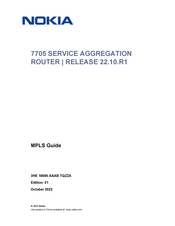Nokia 7705 SAR-W Series Manuals
Manuals and User Guides for Nokia 7705 SAR-W Series. We have 1 Nokia 7705 SAR-W Series manual available for free PDF download: Manual
Nokia 7705 SAR-W Series Manual (594 pages)
SERVICE AGGREGATION ROUTER, MPLS
Brand: Nokia
|
Category: Network Router
|
Size: 3.57 MB
Table of Contents
-
Preface15
-
Audience15
-
Overview20
-
Mpls21
-
Label Values24
-
LSP Types34
-
Timers49
-
FRR Behavior73
-
Local Protection107
-
Router Interface128
-
Paths128
-
Lsps129
-
Pseudowires129
-
Deleting MPLS142
-
MPLS Commands156
-
RSVP-TE Commands159
-
Show Commands160
-
Clear Commands161
-
Monitor Commands161
-
Debug Commands162
-
Clear Commands287
-
Monitor Commands289
-
Debug Commands296
-
Pcep305
-
PCEP Parameters315
-
Stateful PCE316
-
LSP Initiation319
-
PCC Behavior340
-
PCEP Commands352
-
Show Commands352
-
PCEP Commands354
-
Show Commands359
-
LDP and MPLS369
-
BFD for T-LDP370
-
LDP Architecture370
-
Label Manager371
-
Logger373
-
Service Manager373
-
Execution Flow373
-
Initialization373
-
Session Lifetime373
-
Label Exchange375
-
Cleanup376
-
LDP Filters376
-
Label Operations381
-
ECMP Vs FRR387
-
Feature Behavior394
-
ECMP Support397
-
Oam402
-
ECMP Support403
-
LDP Ipv6410
-
Link LDP411
-
Targeted LDP412
-
FEC Resolution412
-
BFD Operation420
-
Mirror Services421
-
Interoperability424
-
Enabling LDP432
-
Disabling LDP441
-
LDP Commands446
-
Show Commands448
-
Monitor Commands451
-
Clear Commands451
-
Debug Commands451
-
Show Commands482
-
Clear Commands538
-
Monitor Commands540
-
Debug Commands548
Advertisement
Advertisement
